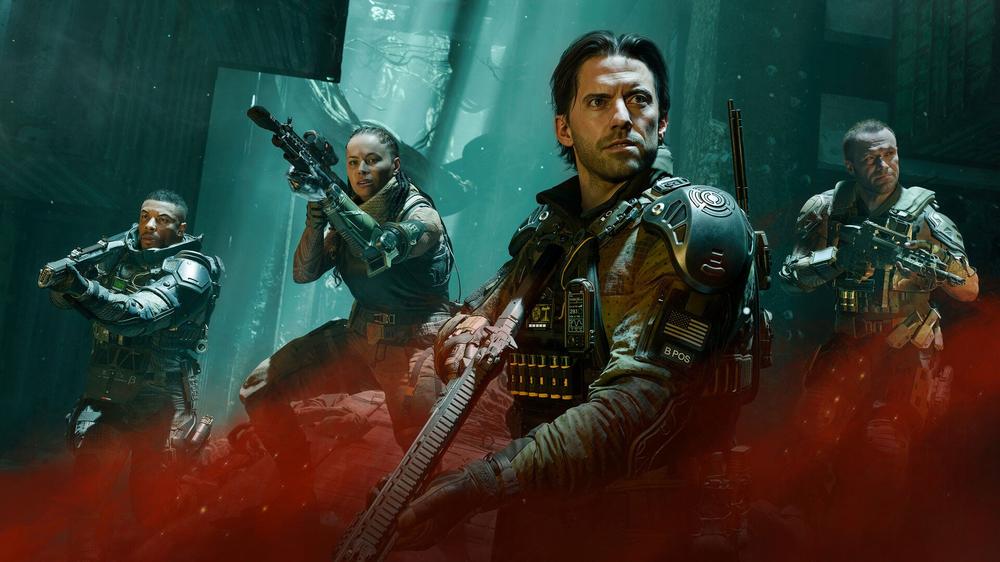Note: This review specifically covers the campaign mode in Call of Duty: Black Ops 7. For our thoughts on the other modes, see our multiplayer review in progress, and our Zombies mode review is still on its way.
Bucking the usual trend of breaks between numbered sequels, Call of Duty: Black Ops 7 is following just 12 months on from Black Ops 6, and you’d perhaps assume that meant only small tweaks to what was one of the series’ high points last year. But the teams at Raven and Treyarch evidently don’t see it that way, and have instead built one of the most unconventional CoD campaigns to date. In many ways, it doesn’t even feel like a CoD single-player mode. It’s more like a multiplayer experiment squeezed into a campaign shell, playing best when you’re accompanied by squadmates, echoing Zombies or the now-defunct DMZ at times. I recently criticised Battlefield 6’s single-player for playing it safe and not taking any risks, and to Black Ops 7’s credit, the same can’t be said here. The problem, however, is that not many of its big swings hit, resulting in one of Call of Duty’s most intriguing, yet flawed campaigns.
Its varied string of missions walks the tightrope between traditional military shooter and schlocky sci-fi nonsense, darting between worlds beyond our technological fingertips and deep within our most haunted of dreams. That spectacle is supported by sharp gunplay and a whole host of gadgetry and abilities that make moving around those worlds incredibly satisfying. But it all culminates in a brand-new endgame portion that stitches together aspects of CoD’s past open-world successes and failures in an attempt to become something new. In reality, that post-credits content is a repetitive shooting gallery that adds little to the excitement that leads up to it.
Much of Black Ops 7’s intrigue emanates from one fundamental design choice: for the first time in many years, a Call of Duty campaign is fully playable in four-player co-op, and it really does feel like it has been made with that in mind as the preferred method of play. This comes with both positives and negatives. Teaming up with friends is good fun, with fighting big bosses that have multiple weak points to fire upon simultaneously or stealthily working through an enemy area tactically, both coming with a good deal of satisfaction. But it also detrimentally affects the solo experience, from not having AI companions fill in for you if no buddies are online, or kicking you for inactivity if you’re idle for too long, to not even being able to pause due to its online-only nature. Its open areas and endgame portion seem catered toward a group experience as well, and can end up just a little lonely when zipping around by yourself. To an extent, it feels like Activision is finally admitting that most people come to its hallmark shooter for multiplayer fun, rather than the single-player story modes the series was founded on.
In fact, having played several missions in both co-op and single-player, I can confirm that playing solo is borderline tedious due to having to repeat multiple objectives, such as placing C4 on a building yourself four times rather than splitting them up as is intended. There are also no difficulty options this time around, meaning that, in theory, it should scale the threat depending on how many players are in your squad. In my experience, though, the number of enemies in a level remains the same, leaving me feeling overwhelmed by foes even in its earliest levels. By comparison, playing in a full squad makes these encounters a breeze, with not enough targets to go around sometimes. In fact, enemy numbers are uneven across the campaign as a whole, sometimes swarming you with dozens of rabid rushers, but at others, presenting you with a couple of soldiers wandering through a door when you’re expecting an onslaught. It’s, admittedly, a difficult balance to get right, but one that has not been achieved here.
As for the structure of the campaign, Black Ops 7’s story is delivered at breakneck speed, taking me just about five hours to reach the endgame. Its 11 missions threw me from one exotic location to the next, from one time period to another, and deep into nightmare realms full of otherworldly horrors and delights. The year is 2035, and new threats are here to instigate a global collapse once again. The re-emergence of Black Ops 2 villain Raul Menendez thrusts the playable unit, Spectre One, into action and soon has them facing off against evil tech company The Guild. What follows is a set of missions that throws you in and out of reality thanks to a fear toxin being weaponised by The Guild, led by Kiernan Shipka’s Emma Kagan, who is trading in Mad Men for mad mechs here.
A combination of cliched evil sci-fi tech corp and Batman Arkham scarecrow-esque antics leads each level to interesting places from a visual perspective, as long-buried memories of our protagonists are dredged up and morphed into horror-filled mazes. It makes for a more varied campaign when it comes to art design, with an impressive number of locations and creatures thematically filling them to gun down. I do wish there was a little more in terms of mission variety when it comes to actual level and objective design, though, with corridor shooting taking the lead in most of these excursions. There’s nothing to rival the creeping intrigue of last year’s Emergence conceptually and its branching objectives and playful enemy design, for example, nor the spy-like cool of infiltrating an embassy fundraiser or high-roller casino.
If last year’s Black Ops 6 leaned more into grounded espionage and subterfuge, 7 is a much louder proposition, choosing to demolish the lobby of a complex to gain access to it rather than sweet-talking the security guard standing in front of it. As a result, there is no shortage of big moments justifying its blockbuster label. Dodging giant falling machetes like you’ve stumbled into a Looney Tunes cartoon is a one-off joy, as is taking control of a lavish luxury boat and ramming into the side of a building. Moments like this feel pinched right out of Christopher Nolan’s back pocket and sit perfectly in the Call of Duty mold.
And that’s just the opening section of one of the standout missions, which takes place in Tokyo and has you dipping into its subway systems and leaping across rooftops. There’s a great sense of forward momentum to levels like these, and I’m a massive fan of them. I just wish more of the campaign were like this Japanese chapter, as I’m not so keen on the ones taking place in the more open-zone areas of the fictional French city-state of Avalon (itself a huge battle royale-sized hub), which struggle to bottle the same exciting energy. These typically have you moving across wider rural patches of its map in order to chase the next cluster of enemies to take down, and essentially serve as tutorials for its endgame. They’re a little less authored than others and fail to capture the same thrills as a result.
In fact, much of the time, it doesn’t really feel like a ‘Call of Duty’ campaign at all. Yes, it has the militaristic hallmarks, but borrows just as much from horde shooters like Left 4 Dead and its own in-house zombie modes. It makes for an uneven set of missions, some of which really don’t work for me, but with others that do manage to hit the spot when they capture some of the CoD cinematic legacy. They’re a rarity, though, and for every one of these, there is also a bizarrely dull sequence, such as the time you’re asked to play Frogger on a twisted, upside-down LA highway.
As you might expect, the gunplay is snappy and satisfying, with SMGs delightfully ripping through armoured enemies and sniper rifles really coming into their own and popping out bits of brain in some of the campaign’s open areas. Each weapon has a good weight to it and is super-responsive when pulling the trigger. It’s Call of Duty, they’ve been doing this for a long time now, and how good its guns feel shouldn’t come as a shock as you rip through enemy healthbars and armor chunks. These extra layers to their vitality do present a slightly more drawn-out cadence to gunfights, though, with a few extra bursts of the trigger needed to take down each. The firearms are supported by a fantastic selection of skills and gadgets, too, with killstreaks making their way into single-player, such as the joyously destructive war machine, allowing for quick mob clean-ups.
I’ll admit, I was initially sceptical of the near-future setting and Call of Duty’s return to tinkering with near-future tech when it comes to movement, but on the whole, the experiment is largely a success. Wall jumping can be a little clunky, but the kinetic super jump is very fun to use as a quick flanking tool, as is my favourite of the bunch, the grapple hook. Swinging up to roofs to find a better vantage point before swooping down on a wingsuit to get back up close opens up each level’s architecture in interesting ways. It may never reach that Titanfall 2 gold standard when it comes to FPS mobility, but there are flashes of it here, which is always welcome.
This desire to experiment also carries into its approach to boss design, which is by no means revolutionary when it comes to FPS campaigns, but a relatively new thing for Call of Duty. I appreciate the efforts made in order to make each have its own gimmick, even if they all ultimately come down to draining an oversized health bar while dodging projectiles. They certainly aren’t complex, but hitting the glowing weak points of a giant, bile-spewing plant in a cave of nightmares is certainly a step up from just pumping bullets into a Juggernaut for the hundredth time, especially when multiple targets are offered up at once and really make the whole co-op nature of the campaign feel worthwhile.
In fact, enemy variety is quite impressive this time around, with human, mechanical, and hallucinatory foes offering different threats that challenge you at all distances. Guild forces include a robot army, as well as traditional militia types such as the machine-gun-wielding Raider, colossal armor-plated Titan, and other NFL team-name adjacent units. Yes, most can be handled with some well-aimed assault rifle fire to the head, but there are more effective ways to deal with them if you choose to explore your arsenal.
I particularly enjoyed one incursion into a robotics lab, which equipped me with a Black Hat hacking device. I liked how it switched up the cadence of the unrelenting bullets a little, and meant I could disrupt and destroy these Terminator wannabes from cover. It even made a miniboss of this zone — an admittedly unexciting rotating turret — easier to take down. I appreciate that, in a game of such ferocious speed as this, you’re occasionally rewarded for taking a breath and using your brain to overcome objectives rather than solely relying on pure firepower.
It’s kind of a shame, then, that once the campaign’s set of linear missions is over, the endgame borrows little of this philosophy. After the main story’s credits have rolled, you’re offered a chance to experience its epilogue, which takes place in the open region of Avalon that’s teased throughout. If you played Call of Duty’s DMZ mode, then you’ll have a rough idea of what to expect here: it’s an extraction shooter, except it's not. You and up to three friends can team up and drop into this battle royale-sized map and complete the activities that litter it with eye-soreing regularity. On every street corner are Guild checkpoints or zombie-infested buildings to clear out as you progress through its difficulty-tiered regions in order to reach its final boss, located at the epicentre of the island’s toxic smog. The catch? If your squad goes down, you lose all of your progress. That progress is mainly tied to your combat rating, a number that goes up the more killing and map icon clearing you do, and it's therefore up to you to know when to call it quits on a certain run and extract from the map within a time limit.
For each level you go up, you’ll get a skill point to plug into any of two given options. These can range from armor plates automatically regenerating when you get kills to overall movement speed or rate of fire increases. The idea is to keep building up your character until you’ve reached the minimum recommended level of 55 and shut down the toxic threat sweeping across Avalon. The progression feels genuine, too, with my character resembling a super soldier at higher ranks, thanks to the sheer amount of speed I harnessed and the damage I could absorb.
In theory, I like this idea and think there are the bones of an exciting mode here — something that could capture the magic the likes of Helldivers 2 has done in recent times — but as is, it unfortunately gets a little tired a little too soon. Objectives are almost all exclusively “go to this place and clear out the enemies there,” which I understand is part of the fundamentals when it comes to shooters, but I would’ve appreciated a little more variety and something that mirrored the minor puzzle-solving sections of the main campaign, or at least clever uses of the gadgetry it introduces. The enemy AI that walks Avalon’s streets is also dumb as bricks and pops out of cover freely, making each encounter a simple affair when you put enough distance between you and them.
Yes, zooming around on grapple hooks and transitioning into wing suit gliding mid-fall is still incredibly satisfying, as is plotting out methods of attack in a four-player squad, but all semblance of interesting level or mission design is traded in upon entry here for a few hours of relatively mindless shooting in order to watch some numbers tick up. In some ways, it sits somewhere between the campaign missions and Zombies in its design, but frustratingly borrows the least interesting aspects of both, neglecting the mission structure and mystery-solving that each mode thrives on. It results in a reasonably enjoyable, but not essential, second serving to the campaign. And don’t worry, if the endgame doesn’t sound like your cup of tea, or even sounds a little daunting (the ferocity of its bullet sponge hordes can get overwhelming in its latter stages, especially when heading in solo), the story does wrap up satisfyingly enough beforehand for it not to feel like you’re missing out on an ending completely.
It’s a story nowhere near as accomplished as last year’s effort, though. Effectively a direct sequel to Black Ops 2 that also ties into the events of Black Ops 6, presumed knowledge and the speed at which its setup is told can be a little disorientating, especially if you aren’t familiar with its 2012 predecessor. The themes are personal this time around, with David “Section” Mason, recast here as Heroes’ Milo Ventimiglia, placed centre stage as he battles with his past – namely the loss of his father, Alex. There are some fun revelations along the way, as well as treats for long-term fans of the Black Ops series, but as someone who has never held those characters in as high regard as their Modern Warfare counterparts, the pulling of the heartstrings didn’t quite work for me.

 Auto elettriche ed ibride Plug-in, le vendite nel mondo crescono anche ad ottobre
Auto elettriche ed ibride Plug-in, le vendite nel mondo crescono anche ad ottobre